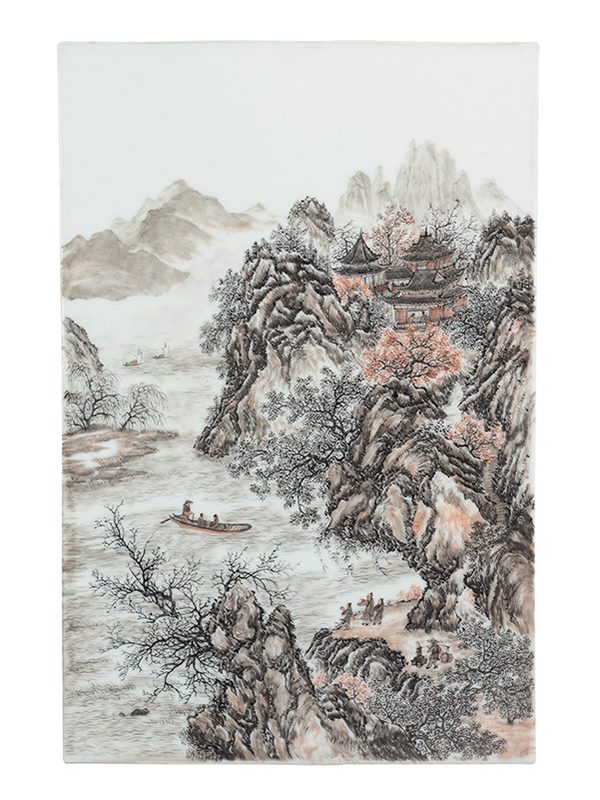Famille rose porcelain plaque with landscape
A rectangular porcelain plaque finely enamelled in delicate hues with a landscape scene. A small boat in the middle of a wavy river carries two literati and a boatman, who is paddling towards the riverbank amongst the mountains. A man accompanied by two attendants stands on the riverbank, whilst a porter carries their luggage and walks toward them. The rugged mountains are adorned with leafy trees on the cliffs, and a narrow footpath meanders towards the top of the mountain, where a group of pagodas is located. Some literati are visible through the studio windows. Overlapping ranges of mountains occupy the right side of the plaque in dark grey and light brownish colour, whilst some light greyish mountains lie horizontally at the far end.
This finely painted plaque perfectly represents traditional Chinese ink landscape painting on porcelain, rather than on a piece of paper. From the mid Qing dynasty onwards the development of porcelain painting prospered. Porcelain artists were committed to transplant Chinese ink painting from paper to porcelain works, including porcelain plaques, screens, brush pots and paperweights. During the late Qing dynasty and the Republic of China period many porcelain painters gathered in Jingdezhen, Jiangxi province. It was not until 1928 that the eight most famous porcelain painters formed the Yue Yuan Hui (The Club of Circular Moon), later known to the collectors as the ‘Eight Friends of Zhushan’.[1] The eight porcelain artists, following the traditional painting style of the ‘Eight Eccentrics of Yangzhou (Yangzhou baguai)’ of the mid Qing dynasty, made porcelain painting become a mainstream of art. This porcelain plaque depicts traditional Chinese landscape painting, Shan shui, literally ‘mountain-water’, referring to a style that depicts scenery or natural landscapes. These landscape paintings usually centre on mountains, which had long been seen as sacred places in Chinese culture. Three comparable porcelain plaques are illustrated in Pian Xie Shan Fang Cang Ci (Porcelain Collection in the Pian Xie Retreat).[2]
Provenance: This plaque was bought in Mexico. It comes from the collection of a lady who died in her 90’s. It is documented that the works of Pan Yongbing (1900-1961), an artist of ceramic fine arts and a native of Boyang county, Jiangxi Province, were exhibited in Panama in the 50’s. The works of many Chinese ceramic artists were included in exhibitions in Central and South America in the 1950’s and 1960’s, so it is likely that this plaque was bought at a local exhibition at that time and subsequently stayed in Central America.
- These eight porcelain artists include Wang Qi, Wang Dafan, Wong Yeting, Zhen Bishan, Bi Botao, He Xuren, Chen Yiting, Liu Yuchen.
- Pian Xie Shan Fang Cang Ci (Porcelain Collection in the Pian Xie Retreat), Hangzhou, Xiling Yin She (Xiling Seal Engraver’s Society Publishing House), 2007, pp. 31, 111, 175
山水人物瓷版畫
民國 二十世紀早–中期 長:41.5公分 寬:28 公分
畫上重巒疊嶂,山勢險峻,樹木叢生,煙霞環繞,頗為壯觀。山上小溪泉水流淌有聲,
山下河中漁夫泛舟,山林間亭台樓閣隱現,這是一處可遊可居的幽雅勝境。近景古樸山
亭中已有文人在裡面論詩作畫,山下可見其他文人或乘舟、或步行趕來應約赴會。山水
勝境為文人雅集提供了優美環境,反之文人雅集又為山水勝境增添了詩情畫意。
來源:墨西哥家族遞藏

